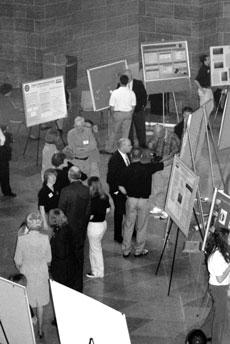Students show their research

University of Missouri students setup several information booths in the third floor Rotunda.
Students from all four University of Missouri campuses came together this week to show legislators what they know.
Between 50 and 60 students from undergraduate and graduate programs spent their Tuesday afternoon in the Capitol building sharing their research.
“This annual event reminds elected officials of the value added to the educational experience kids receive at the University of Missouri,” said Dr. Linda Blockus, director of undergraduate research at the University of Missouri-Columbia. “Our schools are research institutions. Students can get involved in research as early as their freshman year. And that’s something they can’t get at many other institutions in the state.”
The day also offered students the experience of putting their research into laymen’s terms and explaining what they were doing to people who aren’t familiar with language the students would normally use.
“They’re custom to talking about chemical equations, mathematical equations and tables of data,” said Dr. Harvest Collier, vice provost of undergraduate studies at the University of Missouri-Rolla. “Being able to translate what that all means in reasonable terms is something really important for them to know. When scientists and engineers get out into the real world they will have to explain to others how these problems are solved and people generally do not want terms explained in quantitative descriptions.”
And not only did students have to use their research to explain things in terms people understand, the students had to prove the relevance to the state of Missouri.
“Many of the projects could potentially have economic development spin-offs,” Blockus said.
Timothy Hackmann, University of Missouri-Columbia student working on his master’s degree in animal nutrition, said his project was very relevant to Missouri. He is currently looking into how to measure the nutritional value of forage for cattle.
“There is a system used now to predict the nutritional quality of forage, but its inaccurate and very poor,” Hackmann said. “It costs the United States millions of dollars a year.”
Hackmann said several representatives were interested in his project because they come from agricultural districts and Rep. Tom Shively (D-Shelbyville) even invited Hackmann back to his office to talk about the subject.
Your donation will support the student journalists of Missouri Southern State University. Your contribution will allow us to purchase equipment and cover our annual website hosting costs.



























